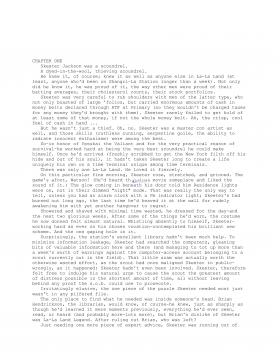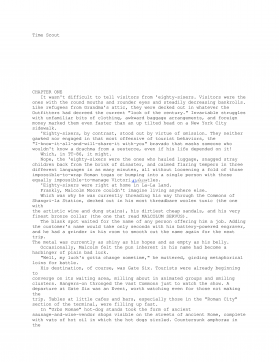
again. Whether I wanted to believe my eyes or not, they insisted there was light in that direction. It was
a gentle yellow-green glow — just the sort of thing you use in lighting effects to give the impression of
an underwater scene. At first it looked uniform and smooth; then, a few turns later and two hundred
feet lower, it showed a pattern. The pattern was of squares, with their corners just a little brighter than
the rest of the area. It didn't cover the whole bottom; its edge was almost below me, and it extended
toward what I thought was the north, though my compass wasn't reacting too well to the tumbling.
In the other direction was the normal comforting and frightening darkness - that was real enough.
Two things happened at almost the same instant. It became evident that I was going to come down
pretty close to the edge of the light area, and it also became obvious what the light area was. The
second realization got to me. For three or four seconds I was so furious and disgusted that I couldn't
plan, and as a result I almost didn't get around to telling this story.
The light was artificial. Believe it if you can.
I realize that for a normal person it's hard. Wasting watts to light up the outdoors is bad enough, but
sometimes it's a sad necessity. Spending power to illuminate the sea bottom, though — well, as I say,
for a few moments I was too furious to think straight. My job has brought me into contact with people
who were careless with energy, with people who stole it, and even with people who misused it; but this
was a brand-new dimension! I was lower now and could see acres and acres of light stretching off to
the north, east, and west until it blurred out of sight. Acres and acres lighted by things suspended a few
yards above the level bottom, things visible only as black specks in the center of slightly brighter areas.
At least, whoever was responsible for this display had some sense of economy; he was using reflectors.
Then I got my anger under control, or maybe my fear did it for me. I suddenly realized that I was only a
few dozen yards above the lights. I was not going to come down among them, but a little to the south. I
couldn't say safely to the south. I couldn't say safely anything, because my assemblage of Pugnose-bow
and safety tank was turning over slowly enough to let me predict the attitude it would have when it hit
bottom, and it looked pretty certain that the open end of the hull would be underneath.
Quite aside from the fact that I wouldn't be able to see anything from under the wreckage, there was the
likelihood that I wouldn't be able to do anything either - such as get back to the surface. This time I did
reach the controls.
Since the whole idea hinged on concealment, the separators used springs rather than squibs. I waited
until the spin put the hulk between me and the light and punched the button. The push was light enough
to make me wonder for a few seconds whether I mightn't be in even worse trouble than I'd supposed.
Then light began to come in through ports which had been covered by the hull, and that worry ended.
The springs had kicked the tank away from the lighted region, so I could see Pugnose's bow outlined
against the luminescence. The separation had slowed our fall very slightly with the wreckage now
going just a trifle faster than I was. At least something was going as planned; the wreck would hit first,
so there should be no chance of my getting trapped under it.
I hadn't expected to see it hit bottom, of course. I would certainly never have expected to see what
happened when it did.
For the most part, level stretches of sea bottom tend to be on the gooey side. They may call it
globigerina ooze or radiolarian ooze, but it's usually ooze. You can meet with coral and sand and other
firm stuff in shallow water and honest rock at times on slopes, but where it's level you expect
something like a cross between ordinary mud and the top couple of inches of a stagnant pond. When
something hard and heavy lands on it, even gently, you don't expect the bottom to give it much support.
You may sometimes be surprised on this matter, but you never count on anything bouncing off the sea
bottom.
Pugnose didn't exactly bounce, I have to admit, but she certainly didn't behave properly. She hit the
lighted surface thirty or forty yards from the edge, and perhaps twice as far from me. I could see easily.
She touched, as expected, and sank in as expected. There was no swirl of silt, though -no sign of the
slow-motion splash you normally see when something lands in the ooze. Instead, the bow section dis-
appeared almost completely into the smooth surface while a circular ripple grew around it and spread
away from the point of impact. Then the wreckage eased gently back up until it was half uncovered,
then back down again, still in slow motion. It oscillated that way three or four times before coming to
rest, and each rebound sent another ripple spreading out from the spot for a dozen yards or so.
By the time that stopped, so had my tank. I felt it hit something hard - rock, for a bet, and I'd have won.
Then it began to roll very, very gently toward the light. I couldn't see the surface I was on at all clearly,
but it seemed evident that it was a solid slope which would deliver me beside the Pugnose in two or
three minutes if I didn't do something about it. Fortunately, there was something I could do.
The tank had what we'd come to call legs, six-foot-long telescoping rods of metal which could be
extended by springs and retracted again by solenoids. I was still hoping not to have to use magnets, but
it seemed that the legs were in order; I propped out four of them in what I hoped were reasonable

 2024-12-08 12
2024-12-08 12
 2024-12-08 14
2024-12-08 14
 2024-12-08 10
2024-12-08 10
 2024-12-08 10
2024-12-08 10
 2024-12-08 15
2024-12-08 15
 2024-12-08 18
2024-12-08 18
 2024-12-08 27
2024-12-08 27
 2024-12-08 25
2024-12-08 25
 2024-12-08 16
2024-12-08 16
 2024-12-08 30
2024-12-08 30








 渝公网安备50010702506394
渝公网安备50010702506394
